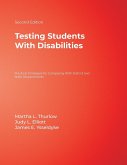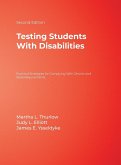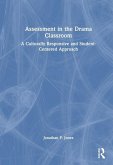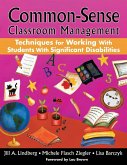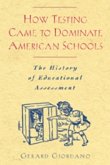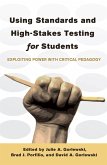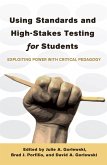- Gebundenes Buch
- Merkliste
- Auf die Merkliste
- Bewerten Bewerten
- Teilen
- Produkt teilen
- Produkterinnerung
- Produkterinnerung
Use teacher-made tests, appropriate testing accommodations, technology-based testing, and classroom-based assessments to give students with diverse needs the opportunity to achieve!
Andere Kunden interessierten sich auch für
![Testing Students With Disabilities Testing Students With Disabilities]() Martha L. ThurlowTesting Students With Disabilities49,99 €
Martha L. ThurlowTesting Students With Disabilities49,99 €![Testing Students With Disabilities Testing Students With Disabilities]() Martha L. ThurlowTesting Students With Disabilities95,99 €
Martha L. ThurlowTesting Students With Disabilities95,99 €![Assessment in the Drama Classroom Assessment in the Drama Classroom]() Jonathan P. JonesAssessment in the Drama Classroom193,99 €
Jonathan P. JonesAssessment in the Drama Classroom193,99 €![Common-Sense Classroom Management Techniques for Working With Students With Significant Disabilities Common-Sense Classroom Management Techniques for Working With Students With Significant Disabilities]() Jill A. LindbergCommon-Sense Classroom Management Techniques for Working With Students With Significant Disabilities39,99 €
Jill A. LindbergCommon-Sense Classroom Management Techniques for Working With Students With Significant Disabilities39,99 €![How Testing Came to Dominate American Schools How Testing Came to Dominate American Schools]() Gerard GiordanoHow Testing Came to Dominate American Schools40,50 €
Gerard GiordanoHow Testing Came to Dominate American Schools40,50 €![Using Standards and High-Stakes Testing for Students Using Standards and High-Stakes Testing for Students]() Using Standards and High-Stakes Testing for Students158,30 €
Using Standards and High-Stakes Testing for Students158,30 €![Using Standards and High-Stakes Testing for Students Using Standards and High-Stakes Testing for Students]() Using Standards and High-Stakes Testing for Students40,50 €
Using Standards and High-Stakes Testing for Students40,50 €-
-
-
Use teacher-made tests, appropriate testing accommodations, technology-based testing, and classroom-based assessments to give students with diverse needs the opportunity to achieve!
Hinweis: Dieser Artikel kann nur an eine deutsche Lieferadresse ausgeliefert werden.
Hinweis: Dieser Artikel kann nur an eine deutsche Lieferadresse ausgeliefert werden.
Produktdetails
- Produktdetails
- Verlag: Corwin
- Seitenzahl: 176
- Erscheinungstermin: 10. November 2009
- Englisch
- Abmessung: 286mm x 221mm x 14mm
- Gewicht: 721g
- ISBN-13: 9781412966429
- ISBN-10: 1412966426
- Artikelnr.: 26251846
- Verlag: Corwin
- Seitenzahl: 176
- Erscheinungstermin: 10. November 2009
- Englisch
- Abmessung: 286mm x 221mm x 14mm
- Gewicht: 721g
- ISBN-13: 9781412966429
- ISBN-10: 1412966426
- Artikelnr.: 26251846
A former teacher in the New York City School System, Spencer J. Salend is a professor at SUNY-New Paltz, where he teaches courses on educational assessment and serves as the coordinator of the Special Education Program. He is the author of the best-selling, easy-to-read, and practical book, Creating Inclusive Classrooms: Effective and Reflective Practices. Widely known for his work in translating research into practice, he has published and presented on such topics as educational assessment, inclusive educational practices, and teaching students from culturally and linguistically diverse backgrounds. In recognition of the significance of his research and its benefits to others, he was selected as a recipient of the State University of New York's Faculty Scholar Award and the Chancellor's Research Recognition Award. He has also served as a project director and program evaluator for numerous federal and state projects and has shared his work by engaging in a variety of professional development and activities.
Acknowledgments
About the Author
Introducing Inclusive Classroom Testing and Assessment Practices
1. Creating and Grading Valid and Accessible Teacher-Made Tests
What Factors Should I Consider in Determining the Content of My Tests?
How Can I Foster the Readability and Legibility of My Tests?
How Can I Format My Tests to Help My Students to Be Organized and Motivated
and to Pay Attention?
How Can I Help My Students Understand and Follow Test Directions?
How Can I Compose Understandable, Useful, Valid, and Appropriate Test
Items?
How Can I Grade My Teacher-Made Tests?
2. Determining and Implementing Valid and Appropriate Testing
Accommodations
What Are the Elements of Valid Testing Accommodations?
What Are the Different Types of Testing Accommodations?
Who Is Eligible to Receive Testing Accommodations?
How Are Valid and Appropriate Testing Accommodations for Students
Determined?
How Can the Implementation of Testing Accommodations Be Fostered?
3. Using Technology-Based Testing
How Can Technology-Based Testing Be Used to Enhance Student Motivation and
Feedback and Minimize Student Errors?
How Can Technology-Based Testing Be Used to Present Test Directions and
Items to Students?
How Can Technology-Based Testing Be Used to Help Students Respond to
Objective Test Questions?
How Can Technology-Based Testing Be Used to Help Students Respond to Essay
Tests Questions?
What Concerns Need to Be Considered and Addressed When Using
Technology-Based Testing?
4. Teaching Effective Study and Test-Taking Skills and Strategies
How Can I Assess My Students? Study and Test-Taking Skills and Strategies?
What Effective Study Skills and Strategies Do My Students Need to Learn?
What Effective Test-Taking Skills and Strategies Do My Students Need to
Learn?
How Can I Help My Students Who Experience Test Anxiety?
How Can I Teach Effective Study and Test-Taking Skills and Strategies to My
Students?
How Can I Work With My Students? Families to Support Their Children?s Use
of Effective Study and Test-Taking Skills?
5. Using Classroom Assessments
How Can I Use Classroom Assessments to Monitor the Learning Progress of My
Students?
How Can I Use Classroom Assessments to Implement Performance Assessment?
How Can I Use Technology to Implement Performance Assessment?
Appendix A
Appendix B
References
Index
About the Author
Introducing Inclusive Classroom Testing and Assessment Practices
1. Creating and Grading Valid and Accessible Teacher-Made Tests
What Factors Should I Consider in Determining the Content of My Tests?
How Can I Foster the Readability and Legibility of My Tests?
How Can I Format My Tests to Help My Students to Be Organized and Motivated
and to Pay Attention?
How Can I Help My Students Understand and Follow Test Directions?
How Can I Compose Understandable, Useful, Valid, and Appropriate Test
Items?
How Can I Grade My Teacher-Made Tests?
2. Determining and Implementing Valid and Appropriate Testing
Accommodations
What Are the Elements of Valid Testing Accommodations?
What Are the Different Types of Testing Accommodations?
Who Is Eligible to Receive Testing Accommodations?
How Are Valid and Appropriate Testing Accommodations for Students
Determined?
How Can the Implementation of Testing Accommodations Be Fostered?
3. Using Technology-Based Testing
How Can Technology-Based Testing Be Used to Enhance Student Motivation and
Feedback and Minimize Student Errors?
How Can Technology-Based Testing Be Used to Present Test Directions and
Items to Students?
How Can Technology-Based Testing Be Used to Help Students Respond to
Objective Test Questions?
How Can Technology-Based Testing Be Used to Help Students Respond to Essay
Tests Questions?
What Concerns Need to Be Considered and Addressed When Using
Technology-Based Testing?
4. Teaching Effective Study and Test-Taking Skills and Strategies
How Can I Assess My Students? Study and Test-Taking Skills and Strategies?
What Effective Study Skills and Strategies Do My Students Need to Learn?
What Effective Test-Taking Skills and Strategies Do My Students Need to
Learn?
How Can I Help My Students Who Experience Test Anxiety?
How Can I Teach Effective Study and Test-Taking Skills and Strategies to My
Students?
How Can I Work With My Students? Families to Support Their Children?s Use
of Effective Study and Test-Taking Skills?
5. Using Classroom Assessments
How Can I Use Classroom Assessments to Monitor the Learning Progress of My
Students?
How Can I Use Classroom Assessments to Implement Performance Assessment?
How Can I Use Technology to Implement Performance Assessment?
Appendix A
Appendix B
References
Index
Acknowledgments
About the Author
Introducing Inclusive Classroom Testing and Assessment Practices
1. Creating and Grading Valid and Accessible Teacher-Made Tests
What Factors Should I Consider in Determining the Content of My Tests?
How Can I Foster the Readability and Legibility of My Tests?
How Can I Format My Tests to Help My Students to Be Organized and Motivated
and to Pay Attention?
How Can I Help My Students Understand and Follow Test Directions?
How Can I Compose Understandable, Useful, Valid, and Appropriate Test
Items?
How Can I Grade My Teacher-Made Tests?
2. Determining and Implementing Valid and Appropriate Testing
Accommodations
What Are the Elements of Valid Testing Accommodations?
What Are the Different Types of Testing Accommodations?
Who Is Eligible to Receive Testing Accommodations?
How Are Valid and Appropriate Testing Accommodations for Students
Determined?
How Can the Implementation of Testing Accommodations Be Fostered?
3. Using Technology-Based Testing
How Can Technology-Based Testing Be Used to Enhance Student Motivation and
Feedback and Minimize Student Errors?
How Can Technology-Based Testing Be Used to Present Test Directions and
Items to Students?
How Can Technology-Based Testing Be Used to Help Students Respond to
Objective Test Questions?
How Can Technology-Based Testing Be Used to Help Students Respond to Essay
Tests Questions?
What Concerns Need to Be Considered and Addressed When Using
Technology-Based Testing?
4. Teaching Effective Study and Test-Taking Skills and Strategies
How Can I Assess My Students? Study and Test-Taking Skills and Strategies?
What Effective Study Skills and Strategies Do My Students Need to Learn?
What Effective Test-Taking Skills and Strategies Do My Students Need to
Learn?
How Can I Help My Students Who Experience Test Anxiety?
How Can I Teach Effective Study and Test-Taking Skills and Strategies to My
Students?
How Can I Work With My Students? Families to Support Their Children?s Use
of Effective Study and Test-Taking Skills?
5. Using Classroom Assessments
How Can I Use Classroom Assessments to Monitor the Learning Progress of My
Students?
How Can I Use Classroom Assessments to Implement Performance Assessment?
How Can I Use Technology to Implement Performance Assessment?
Appendix A
Appendix B
References
Index
About the Author
Introducing Inclusive Classroom Testing and Assessment Practices
1. Creating and Grading Valid and Accessible Teacher-Made Tests
What Factors Should I Consider in Determining the Content of My Tests?
How Can I Foster the Readability and Legibility of My Tests?
How Can I Format My Tests to Help My Students to Be Organized and Motivated
and to Pay Attention?
How Can I Help My Students Understand and Follow Test Directions?
How Can I Compose Understandable, Useful, Valid, and Appropriate Test
Items?
How Can I Grade My Teacher-Made Tests?
2. Determining and Implementing Valid and Appropriate Testing
Accommodations
What Are the Elements of Valid Testing Accommodations?
What Are the Different Types of Testing Accommodations?
Who Is Eligible to Receive Testing Accommodations?
How Are Valid and Appropriate Testing Accommodations for Students
Determined?
How Can the Implementation of Testing Accommodations Be Fostered?
3. Using Technology-Based Testing
How Can Technology-Based Testing Be Used to Enhance Student Motivation and
Feedback and Minimize Student Errors?
How Can Technology-Based Testing Be Used to Present Test Directions and
Items to Students?
How Can Technology-Based Testing Be Used to Help Students Respond to
Objective Test Questions?
How Can Technology-Based Testing Be Used to Help Students Respond to Essay
Tests Questions?
What Concerns Need to Be Considered and Addressed When Using
Technology-Based Testing?
4. Teaching Effective Study and Test-Taking Skills and Strategies
How Can I Assess My Students? Study and Test-Taking Skills and Strategies?
What Effective Study Skills and Strategies Do My Students Need to Learn?
What Effective Test-Taking Skills and Strategies Do My Students Need to
Learn?
How Can I Help My Students Who Experience Test Anxiety?
How Can I Teach Effective Study and Test-Taking Skills and Strategies to My
Students?
How Can I Work With My Students? Families to Support Their Children?s Use
of Effective Study and Test-Taking Skills?
5. Using Classroom Assessments
How Can I Use Classroom Assessments to Monitor the Learning Progress of My
Students?
How Can I Use Classroom Assessments to Implement Performance Assessment?
How Can I Use Technology to Implement Performance Assessment?
Appendix A
Appendix B
References
Index

